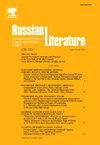接触追踪战争与和平:社会网络分析中的一个批判性实验
IF 0.2
3区 文学
0 LITERATURE, SLAVIC
引用次数: 0
摘要
这篇文章采用了一种新颖的方法,对托尔斯泰的长篇巨著《战争与和平》进行小说的社会网络分析。我们提出一种优先考虑物理接近度的方法,与基于文本中角色名称接近度的小说中提取社交网络的典型方法形成了鲜明的对比。除了方法论上的论证,这篇文章还对小说中人物在社会网络中的位置以及小说各部分中社会网络的变化性质进行了评论。我们论证了托尔斯泰在小说的前半部分建立了一个紧密的“社会中心”,而后半部分则崩溃了。本文章由计算机程序翻译,如有差异,请以英文原文为准。
Contact-Tracing War and Peace: A Critical Experiment in Social Network Analysis
The piece applies a novel approach to the social network analysis of fiction to Tolstoy’s sprawling masterpiece, War and Peace. We propose that an approach that prioritizes physical proximity provides an illuminating contrast to the typical methods for extracting social networks in fiction that are based on the proximity of character names within the text. In addition to its methodological argument, this article offers commentary on the positions of characters within the novel’s social network and the changing nature of that social network across the novel’s parts. We demonstrate that in the first half of the novel Tolstoy builds a tight-knit “social center” that the second half breaks down.
求助全文
通过发布文献求助,成功后即可免费获取论文全文。
去求助
来源期刊

RUSSIAN LITERATURE
LITERATURE, SLAVIC-
CiteScore
0.60
自引率
0.00%
发文量
50
期刊介绍:
Russian Literature combines issues devoted to special topics of Russian literature with contributions on related subjects in Croatian, Serbian, Czech, Slovak and Polish literatures. Moreover, several issues each year contain articles on heterogeneous subjects concerning Russian Literature. All methods and viewpoints are welcomed, provided they contribute something new, original or challenging to our understanding of Russian and other Slavic literatures. Russian Literature regularly publishes special issues devoted to: • the historical avant-garde in Russian literature and in the other Slavic literatures • the development of descriptive and theoretical poetics in Russian studies and in studies of other Slavic fields.
 求助内容:
求助内容: 应助结果提醒方式:
应助结果提醒方式:


